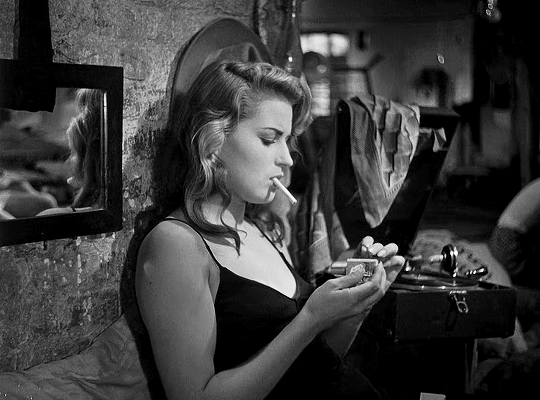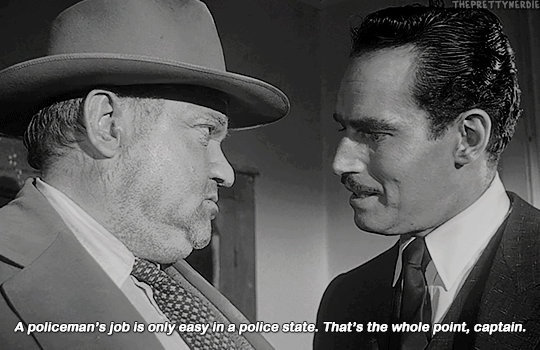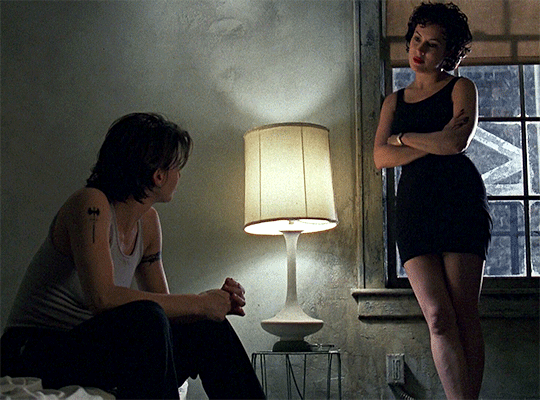#in the good year of 2023 i was coerced heavily into this
Explore tagged Tumblr posts
Text

you guys will never believe what i just got into
#doctor who#tenth doctor#rose tyler#tenrose#morgan’s art#artists on tumblr#doodles#in the good year of 2023 i was coerced heavily into this#and i totally am not super obsessed w it right now i swear#we recently finished season 4 n the specials#no im not FINE
103 notes
·
View notes
Text
CC's New Watch Ranking - April 2023



Every month on Letterboxd, I make a list of the 10 best films I’ve seen for the first time. It’s a fun way to compare movies separated in time, genre, and country of origin, and helps me keep track of what I’m watching! This is a breakdown of those films.
April! An early heat wave broke and gave us the rainy, misty days that this month is supposed to contain. My vegetable garden is starting to take root. This is the first year I’m planting in earnest, prepping trays of seeds to make their way outside. I’ve been learning a lot, and keeping my eye on the backyard window as I’ve been settling in to watch these films. Plants like music - do they like film scores? Maybe I’ll take my speakers outside and find out. I bet they’d love Angelo Badalamenti, whose work is featured heavily in this month’s list. After a slow start due to several exciting new work opportunities (yay!), this month ended up containing some cinematic heavy-hitters!
Click below to read the breakdown! Click HERE for the list on Letterboxd!
10. The Hawks and the Sparrows
1966 - Pier Paolo Pasolini

A delightful absurdist tale by one of Italy’s greatest directors. A father and son, whose attitude seems ripped right out of Waiting for Godot, wander a road with indeterminate purpose. Along they way they meet a philosophizing talking bird, and fall backwards in time to the life of St. Francis. Interspersed are some scenes of modern (1960s) Italian life, including the real funeral procession of a Communist leader. It’s a strange, lopsided work, perhaps not achieving the thought-provoking or artistic heights that the director intended, but contains some brilliant gems of absurdism. I’m particularly struck by several shots and discussions that focus on the Moon. You may know, reader, that I am obsessed with Fellini’s Voice of the Moon. That is an absurd, wandering meditation on the moon’s symbolism and power, and echoes of those ideas are found here, too. It gets me wondering about what Fellini and Pasolini shared, the experiences that united their thought, and got them to create such interesting, parallel pictures.
9. For a Few Dollars More
1965 - Sergio Leone

Impeccable craft. The platonic ideal of a Western that so many movies/other media try to grasp, but can never quite achieve. (Looking at you, Mando.) While The Good, The Bad, and The Ugly might be the ultimate piece in this trilogy, For A Few Dollars More still manages to hold all the compelling, subtle characterization and breathtaking conclusion that makes that capper so legendary. Two bounty hunters seek out a mad fugitive - they all double-cross one another in pursuit of victory. There’s just grand vibes within this thing. A legendary score, gorgeous shots, handsome sweaty men trying to kill each other (aka flirting), and other tiny design choices that are beyond iconic. What’s not to love? Toss this on with a bourbon, pardner, and watch them shoot a hat.
8. Bitter Rice
1949 - Giuseppe De Santis

What if we fought back against systems that oppress the workers of the rice fields AND we were both girls 👀. First and foremost watch this if you love wlw - there is some subtext that occurs between the main pair as they squabble. A jewel thief, coerced into crime by her shitty boyfriend, hides out among rice workers with her stolen goods. She meets Silvana, a peasant who catches onto their scheme and ultimately gets entangled in their lives. It feels like both the thieving pair lust after her. The politics of this one are messy, to say the least. Francesca, the thief, sides with some scabs who want to work the fields despite not being part of the union. Silvana organizes the workers against them, but ultimately they come to a patronizing compromise to let both sides work together. The film doesn’t care about the details that would make this labor struggle real - what does it take to join the union? Who organizes it? Do the members get to vote about how they feel about the scabs? Pulling those threads makes the movie collapse, along with the shoe-horned melodramatic ending for Silvana, which seems born out of an American Hayes Code sense of what must happen to a woman who "chooses wrong." Despite these elements, the film is shot beautifully by Otello Martelli, Fellini’s cinematographer, and contains one of the greatest framing devices for a neorealist film ever devised. A voice over telling you that what you’re about to see is the real testimony of rice workers, which diegetically shifts into a radio announcer present at the scene, is inspired. A film to yell at as you enjoy it.
7. Touch of Evil
1958 - Orson Welles

The film opens with a bomb being place in the boot of a car. Then there is an unbroken shot lasting about 5 minutes of that same car driving slowly through a crowded street. It is breathtaking tension building. Hitchcockian perfection. What follows is a surprisingly nuanced exploration of police corruption. These pigs live in paranoid fantasies sustained by evidence that they plant - hatred, ignorance, and alcohol let them forget that they created the justification for their hate themselves. This film drips with noir style and culminates in a chase scene that’s just as satisfying as the end of The Third Man. Who else understands noir like Welles? He gives a remarkable performance here.
6. Inland Empire
2006 - David Lynch

Lynch was doing creepypasta lo-fi found footage before it was cool. Seriously, watch this film and be surprised that this came out before Marble Hornets! Lynch’s first foray into digital filmmaking follows the story of actor Nikki Grace, played by the inimitable Laura Dern. (Consider her!) She is cast in a film that she later discovers is an adaptation, derived from a production that was shut down due to strange events happening to the cast. This grounded framing quickly dissolves into classic Lynchian surreality. The narrative is intersected by stories of 19th century Polish sex workers, modern day drifters, an unnamed woman who watches the film’s events on a TV screen, and more flashes of disconnected images than I could ever try to remember. Terry Crews is there for a few minutes. Lynch’s films defy simple explanation, as their very structure seems to repel logical attempts to define them. It is enough to say that this all builds into a moving tale of the exploitation built within the Hollywood machine. To be an actor, even with all the progress we’ve made, is to give yourself up to depersonalization, to completely vanish in the eyes of the viewer. Audiences want to see a self that is inside you, but is not you. You can get lost pulling on that thread. And there are dark figures who are only too happy to encourage you to get lost, who want to sit behind a camera and watch your selves separate, so they can bottle it up and sell it for massive, massive profit. Fascinating to see such a film come from Lynch, who by all accounts is a highly ethical filmmaker and whose crews (particularly Dern!) adore working with him. I think it takes a fundamentally good and kind person to truly understand evil - they must have the good grace to recognize what lives within them, what lives within all of us.
(Also, these fucking rabbits terrify me in ways that I'm still understanding. I think I saw the short film Lynch made with them while I was under the influence of certain substances. They know what I'm thinking and will show up at my doorstep one midnight, I just know it.)
5. Lost Highway
1997 - David Lynch

Whereas Inland Empire explores the loss of self that’s a feature (not a bug) of acting, Lost Highway explores a broader loss of self that can happen any time, anywhere, to anyone. Recapping the plot, again, seems a little pointless, but in brief, it’s about a jazz musician who appears to be stalked by a shapeshifting entity. As he tries to understand why he’s being targeted, he gets arrested for (apparently) murdering his wife - but while in jail, he mystically transforms into another person entirely. This new character lives an entirely separate life that eventually intersects with the original one in shocking ways. It’s all very cyclical, and vague, and contains a host of implications that are too broad to clearly explain. Lynch is the ultimate Oneric filmmaker in this way - the content of the dream is so different than the lasting impression it gives you. Towards the beginning of the movie the main character has this exchange:
Fred: "I like to remember things my own way"
Cop: "What does that mean?"
Fred: "How I remember them, not necessarily how they happened"
That’s the ultimate explanation of how these films function. They are truly symbolic masses that pass through you, live inside you, and then transform into something greater than its sum ingredients.
4. Bound
1996 - The Wachowskis

So after dipping our toes into that Lynchian, vaguely defined dreamscape, here we have a much more straightforward film. What if the hottest most gorgeous most sapphic most jaw-droppingly sexy women imaginable did a crime together??? Wouldn’t that be cool?????? There really isn’t much in the way of symbolic nuance in this picture like there is in some of these other recommendations. This is just a straight-forward, tightly constructed crime thriller, starring (cannot emphasize this enough) just the biggest queerest icons you can imagine. I knew this movie would rewire me once I saw it, and am pleased to report that it really, really has. If you’re in the sapphic camp please check it out - it’s as required viewing as But I’m A Cheerleader is. Corky is a stone-butch ex-con who’s hired to renovate an apartment. She discovers that living next door is a mobster and his disaffected trophy girl Violet. Violet seduces Corky in the most noir femme fatale porn-adjacent way imaginable - quite literally “can you fix my pipes?” - and the two agree to pull one over on the mob so they can run off into the sunset. What follows is tightly constructed, steaming tension, as Hithcockian in perfection as Touch of Evil’s opening oner, but with a little more pulpy crass. Gays and theys, please, do not hesitate to watch this. It’s the film that let the Wachowskis make the Matrix, it is truly that spectacular.
3. The Immortal Story
1968 - Orson Welles

Welles is a master storyteller, a magician, a ponderous and monologuing baron of Art whose work is now embedded in the history of this medium. When he’s not playing himself, he’s playing corrupt, ignorant men. What do you think compels him to do that? He had the power and resources to play anyone he wants - why was this the role he chose? These questions will naturally rise up when you’re watching The Immortal Story, Welles’ last feature fiction that he would ever direct. It follows the story of a wealthy businessman who has a meeting with his assistant late one night. The businessman - this baron - reveals that he despises fiction, and only wishes to tell or hear things that are true, like data in a ledger. But then he reveals a story a sailor once told him, about a wealthy man who once paid the sailor to sleep with his wife and produce an heir. His assistant knows the story; he says this is a common folk tale, repeated in every port, on every ship, and that his master is incorrect in believing he heard it from the person it actually happened to. This sends the businessman on an obsessed journey - he commands his assistant to recreate this tale, to hire a courtesan, to find a poor sailor, and reconstruct this tale exactly as it was told to him, line-by-line, so that… well, the baron’s reasons for recreating this tale are obscure. Obsession? Stubbornness? A late-life spark of creativity? These questions intermingle with the first few I proposed. What impresses me so much about this film is that it is Welles clearly exploring his own creative drive, questioning all the motivations that have driven him to the life he has been leading for decades. It’s an incredible meditation from one of cinema’s greatest filmmakers. I firmly believe it sets the ground for the future explorations of truth and fiction that Welles accomplishes in F for Fake. How appropriate that this is the capstone towards his fiction-telling career.
2. Mulholland Drive
2001 - David Lynch

The perfect fusion, and appropriate mid-point, between Lost Highway and Inland Empire. Lynch explores the fundamentals of identity as two people try to discover who they are within the mad dreamscape that is Los Angeles. A woman stumbles out of a car crash into the home of a newly-arrived dreamer, ready to go on an adventure and help this woman restore her identity. Or, perhaps the real story is that a jealous actress clings to a more successful starlet, but gets her heart toyed with and torn to pieces as part of some power-tripping game. Lynch is a master of montage, assembling seemingly random moments into a cohesive whole that leaves a distinct emotional message. The competing, lopsided, cyclical narratives that make up this film are no exception. All the cutaways to different characters that intersect with the main pair’s lives are incredible, too. This is the Lynch film that most feels like it captures life itself. Its many contradictions and absurdities, its passion and revulsion. The highlight is the scene where the protagonists sit and watch an underground show. “It's all just a recording,” the performer repeats. This film is just a recording. Our lives will become a recording, once we’re gone and can only be remembered by artifacts. In this moment the movie seems to speak to the viewers directly, reminding them that everything they’re watching is false - and they’re allowed to let it transport them to other realms, anyway.
1. The Music Room
1958 - Satyajit Ray

One of the things I like most about movies from before, say, 1975, is that they don’t mind really lingering in a certain mood. Much of this movie shows a bored man, descended from royalty, lounging around his dilapidated palace. He hides from responsibility, debts, and truths he’d rather forget. But one doesn’t get bored watching him linger. Almost like a survivor in a horror movie hiding from a monster, Biswambhar is actively hiding, actively moping and avoiding the reality of his situation at any cost. It is a remarkable effect. Biswambhar’s only passion in life is live music, and his music room is his treasure. When his family meets a tragic turn of fate, he is left alone in his palace, situated on a flood plain that will eventually sweep away all his land. He decides to spend the rest of his life waiting for the day, living on ever-dwindling reserves of treasure and sherbet. Destiny seems to call to him at one point, and he decides to spend the rest of his reserve on one final, grand act, like in the good-old-days. He hires a musician, invites all his neighbors, and acts like he hasn’t been a reclusive hermit for several years. We understand him the most in this moment. The way he lights up, reopening the music room. The fantasy he embodies. As the musician plays, and we linger in the majesty of her dance and the hammering tabla, we are mesmerized just as he is. Cascades of meaning become clear. This man has sacrificed everything just for this moment, has given it all away to live inside a happy bubble, shunning the outside world… and can you blame him? How can anything life offers compare to the astral travel music can provide? If only he could have found a way to balance his obligations and this passion. Maybe if he had been a musician himself. But no. He can only watch… just as we, watching this movie, are now. Satyajit Ray is a director most capable of making the audience question itself, whose films seem to provoke deep thought and lingering wonder long after the work is over. This film might be the greatest example of that ability. As our own world changes in uncertain times, with an unclear future, a film like this forces us to question just what we’re doing consuming so much media. Like Biswambhar, I think many of us are turning a blind eye to environmental change so we can linger in the happiness of the music room, too. That’s the lesson to take away from this film. One can’t live their life waiting for that room to contain magic once again…
~~~~~~~~~~~~~~~
Thank you for reading! If you liked any of these thoughts feel free to follow me on Letterboxd, where I post reviews and keep meticulous track of every movie I watch. Look forward to more posts like these next month!
#movies#film#cc oc#letterboxd#movie ranking#The Music Room#Mulholland Drive#The Immortal Story#Bound#Lost Highway#Inland Empire#Touch of Evil#Bitter Rice#For A Few Dollars More#The Hawks and the Sparrows
15 notes
·
View notes
Text
We promised this vaccine waiver 20 years ago

The world’s 125 poorest countries (2.5b people) have received zero covid vaccine doses to date. The 85 poorest countries project vaccination in 2023/24. This is vaccine apartheid.
https://pluralistic.net/2021/05/21/wait-your-turn/#vaccine-apartheid
It’s not that poor countries can’t make their own vaccines. The Global South has a lot of vaccine production capacity. The problem is Big Pharma, which refuses to transfer the patents and know-how to repurpose those facilities for mRNA production.
https://docs.google.com/spreadsheets/d/1IhL-aGt5dEOVegy4eksgs4T6vDl6L6NbY_YJdvDonBI/edit#gid=0
South Africa and India have petitioned the WTO for a vaccine waiver. We should all want this: first, because it is monstrous to doom millions to die in order to preserve the regulatory privileges of a handful of hugely profitable, heavily subsidized pharma companies.
But second, even if you don’t care about being monstrous, a waiver is needed to ensure all our survival: the longer and wider the virus circulates, the more mutations we’ll get, with the mounting risk of a more virulent, more lethal, more vaccine-resistant strain.
The pharma industry has an army of high-paid lobbyists (including Howard Dean), and volunteer simps (like Bill Gates) who are pushing the story that a waiver is unfair and counterproductive, a betrayal of the fundamental patent bargain.
https://pluralistic.net/2021/05/15/how-to-rob-a-bank/#roll-the-dice
They say that the pharma companies committed their capital to vaccine research because we, the people of the world, had promised them exclusive rights to those discoveries (notwithstanding that we also paid for the vast majority of that R&D).
If we alter the deal now, how can pharma trust us next time?
Of all the lies told by the pharma industry about the pandemic, this is the most insidious. Because that’s not how the global patent system works at all.
Gen Xers and their elders will remember the summer of 1999 and the Battle of Seattle, where anti-globalization activists fought for weeks to block the signing of the WTO agreement and its chapter on IP, the TRIPS agreement.
The WTO agreement fundamentally changed the way global patents worked.
Prior to the WTO, it was common for poor countries to completely ignore the patents issued by rich countries (unless the World Bank or a former colonial power coerced them into recognizing these claims).
That’s because countries that are net importers of finished goods have no reason to honor their suppliers’ claims — doing so merely burdens their own struggling manufacturers by forcing them to pay rent to rich foreigners.
This creates drag on local development, ensuring that importer countries stay importers, never becoming self-sufficient.
Ignoring other countries’ exclusive rights regimes — copyright, patent, trademark, etc — is a tried-and-true method to gain self-sufficiency.
That’s why the Framers of the US Constitution decided that America would ignore foreign patents and copyrights, a policy that persisted for over a century, only ending once the US became a net exporter of ideas and inventions, and thus stood to gain more than it lost.
Not just the US, of course. Many European nations spent a century or two a-pirating while their developed their capacity. The Dutch, for example, abolished patents during much of the 19th and 20th centuries.
It doesn’t make sense for a poor country to pay a rich country for rent on ideas. At least, it doesn’t make sense from the perspective of the poor countries.
It’s easy to see what rich countries get out of the deal.
That’s where the WTO (and specifically TRIPS) came in.
TRIPS proposed a bargain to poor countries: if you pay rent on rich countries’ ideas (by recognizing their patents, trademarks and copyrights), we’ll engineer the system so that you become the favored manufacturing contractors for rich countries.
This creates jobs in the short term, and, long term, it builds capacity, by teaching people how to build and operate complex systems.
It’s a form of “technology transfer” that replaces the old adversarial system of rent-collectors and tenant states with global cooperation.
This was a dubious proposition, but the WTO threw in a sweetener: a provision for emergengy waivers. These meant that if there was ever a situation where honoring foreign patents would result in domestic mass-death, those offshore obligations would be immediately suspended.
Think about that for a second. The pharma industry wants you to think that a vaccine waiver reneges on the bargain the world made with it.
But that was never the bargain.
The bargain the Global South struck was, “We will pay rent on rich countries’ ideas. In exchange, we’ll get capacity-building help. In case of emergency, all bets are off: not only will we get access to ideas for free, the WTO will use its might to force tech transfer.”
That’s the bargain pharma signed up for. The claim that a waiver reneges on the deal is truly Orwellian, a heads-I-win-tails-you-lose proposition where poor countries pay rent on ideas and get NOTHING in return — save death and the option to pay yet more rent.
“The TRIPS Intellectual Property Waiver Proposal: Creating the Right Incentives in Patent Law and Politics to end the COVID-19 Pandemic” is a preprint of an LSE Legal Studies Working Paper by a group of Anglo-Irish legal and poli sci scholars.
https://papers.ssrn.com/sol3/papers.cfm?abstract_id=3851737
First published yesterday, it delves into a detailed account of this dynamic, and opens with a devastating argument:
If the pharma companies are right and poor countries truly don’t have the capacity to build vaccine factories, then the WTO is a failure.
The whole point was to build capacity.
If it’s not there, then all the rents the poor world paid all century were a lethally squandered opportunity — they should have followed in the footsteps of America and the Netherlands and ignored the rent demanded by wealthy lands.
The authors describe how pharma gamed the system in the WTO decades. For example, companies devote enormous energy to patenting small variations on their processes and products, allowing them to extend the life of their patents long beyond the 20 years they’re promised.
This produces some genuinely hideous outcomes. In Patrick Radden Keefe’s EMPIRE OF PAIN, the author documents how the Sackler family contemplated seeking regulatory approval to prescribe Oxycontin to children in order to extend the life of their patents.
https://www.inverse.com/mind-body/patrick-radden-keefe-empire-of-pain-interview/amp
It’s hard to imagine how we’ll survive the pandemic crisis without a waiver. COVAX, the “voluntary” system that lets billionaires, corporations and rich countries offer vaccine doses to poor countries as charity, is a total disaster.
COVAX has only raised pledges of 20% of the needed doses — and it isn’t delivering on those pledges.
The system isn’t just failing by accident — the pharma companies are actively sabotaging it.
C-TAP, the WTO’s own scheme for pooling vaccine production know-how, has failed, largely because companies like Pfizer and Biontech have forced NDAs on their contractors that prevent them from participating in the program.
https://contracts.justia.com/companies/maravai-lifesciences-holdings-inc-11469/contract/137780/
The pharma companies have refused to license for mRNA vaccines for production in both in the rich world (Canada, Israel and Denmark) and the poor world (Bangladesh).
The deals pharma struck with the global south don’t just bump the world’s poorest to the back of the line — they also charge the poorest people the highest prices for vaccines. Astrazeneca is charging South Africa twice the going rate in the EU.
https://www.theguardian.com/world/2021/jan/22/south-africa-paying-more-than-double-eu-price-for-oxford-astrazeneca-vaccine
This price-gouging is papered over with misleading claims of charity — for example, Moderna says it won’t extract profit from Brazilians Fiocruz until the pandemic ends — but the agreement allows Moderna to declare the pandemic over in July.
https://www.ft.com/content/c474f9e1-8807-4e57-9c79-6f4af145b68671O
Pharma’s claims of acting in the public interest are pure fantasy.
Pfizer says it makes a 20% profit by selling vaccines it makes for $3/dose at $19.50/dose (“the pandemic price”) — and promises that this price will go up to $175/dose for boosters.
https://s21.q4cdn.com/317678438/files/doc_financials/2020/q4/PFE-USQ_Transcript_2021-02-02.pdf
The very idea of pharma patents is surprisingly new. France instituted pharma patents in 1960; Ireland, 1964; Germany, 1968; Japan, 1976. Pharma demanded these patents to produce the “incentive” to invest, but the bulk of basic pharma R&D is still publicly funded.
Take the Astrazeneca vaccine, developed at Oxford. Between 97.1 and 99% of the funding for that research came from public sources, not Astrazeneca’s profits.
https://doi.org/10.1101/2021.04.08.21255103
The WTO agreement promised the Global South that in a global pandemic, the same might that was used to coerce them into passing laws enforcing rich countries’ patents would be brought to bear on rich countries to force them to help make medicine where it’s needed.
The pharma shills who claim that waiving the patents on mRNA vaccines actually have a point: pharma companies have gamed the patent system so that much of the know-how is never disclosed in patent filings, and the filings themselves are sealed for 18 months.
In the face of this sabotage, the WTO could order rich member states to uphold their obligations by forcing their companies to transfer patents AND trade secrets to poor countries — just as the US forced pharma companies to pool their research on pennicillin during WWII.
That would be the fair thing to do. The right thing to do. The rational thing to do — if we want to ensure the continuation of our civilization and even our species in the face of new mutant strains.
The WTO claimed that poor countries that honored the TRIPS would become tech exporters, building their own domestic capacity. Twenty years later, they’re still importers — and on track to stay that way forever (or until we’re all killed by covid).
The US has no standing to complain about a TRIPS waver. A country that built its fortune and capacity by refusing to pay rent to rich nations for their ideas deserves the same treatment once it becomes rich itself.
76 notes
·
View notes